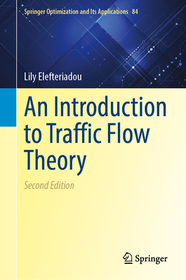
An Introduction to Traffic Flow Theory
Series: Springer Optimization and Its Applications; 84;
- Publisher's listprice EUR 74.89
-
31 060 Ft (29 581 Ft + 5% VAT)
The price is estimated because at the time of ordering we do not know what conversion rates will apply to HUF / product currency when the book arrives. In case HUF is weaker, the price increases slightly, in case HUF is stronger, the price goes lower slightly.
- Discount 12% (cc. 3 727 Ft off)
- Discounted price 27 333 Ft (26 031 Ft + 5% VAT)
Subcribe now and take benefit of a favourable price.
Subscribe
31 060 Ft

Availability
printed on demand
Why don't you give exact delivery time?
Delivery time is estimated on our previous experiences. We give estimations only, because we order from outside Hungary, and the delivery time mainly depends on how quickly the publisher supplies the book. Faster or slower deliveries both happen, but we do our best to supply as quickly as possible.
Product details:
- Edition number 2
- Publisher Springer International Publishing
- Date of Publication 22 April 2024
- Number of Volumes 1 pieces, Book
- ISBN 9783031540295
- Binding Hardback
- No. of pages337 pages
- Size 235x155 mm
- Language English
- Illustrations XVI, 337 p. 137 illus., 113 illus. in color. Illustrations, black & white 556
Categories
Long description:
This second edition of An Introduction to Traffic Flow Theory adds new material in several chapters related to advanced technologies including autonomy, the use of sensors and communications, and particularly congestion mitigation solutions that leverage connected and autonomous vehicles (CAVs). It also includes a new chapter that briefly outlines several mathematical analysis techniques commonly used in traffic flow theory, aiming to introduce students to some of the most frequently used tools available for traffic operational-related analysis. This new edition also includes several updates related to the most recent versions of the Highway Capacity Manual and the Green Book. This textbook is meant for use in advanced undergraduate/graduate level courses in traffic flow theory with prerequisites including two semesters of calculus, statistics, and an introductory course in transportation. The text would also be of interest to transportation professionals as a refresherin traffic flow theory or as a reference. Students and engineers of diverse backgrounds will find this text accessible and applicable to today’s traffic issues.
This text provides a comprehensive and concise treatment of the topic of traffic flow theory and includes several topics relevant to today’s highway transportation system. It provides the fundamental principles of traffic flow theory as well as applications of those principles for evaluating specific types of facilities (freeways, intersections, etc.). Newer concepts of Intelligent transportation systems (ITS) and their potential impact on traffic flow are discussed. State-of-the-art traffic flow research, microscopic traffic analysis, and traffic simulation have significantly advanced and are also discussed in this text. Real-world examples and useful problem sets complement each chapter.
More
Table of Contents:
Introduction.- Part 1.- 1. Modeling the Motion of a Single Vehicle.- 2. Modeling Vehicle Interactions and the Movement of Groups of Vehicles.- Part 2.- 3. The Traffic Stream: Traffic Flow Performance Characteristics.- 4. Capacity.- 5. Traffic Operational Performance Measures.- Part 3.- 6. Analytical Models for Bottleneck and Queuing Evaluations.- 7. Simulation Modeling.- Part 4.- 8. Freeways.- 9. Signalized Intersections and Networks.- 10. Unsignalized Intersections.- 11. Two-Lane Highways.- Appendix A.- Appendix B.- Index.
More



